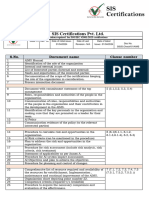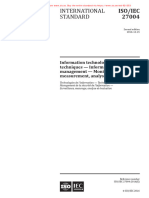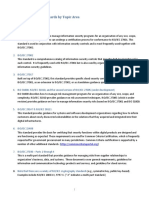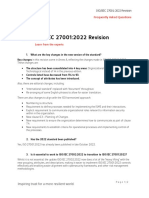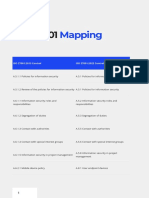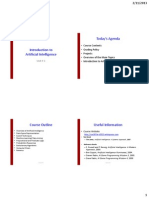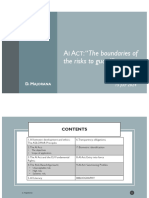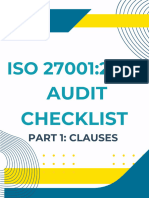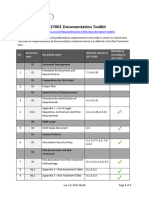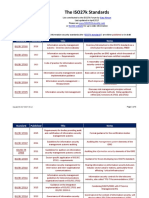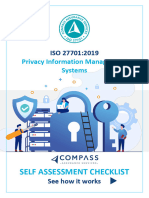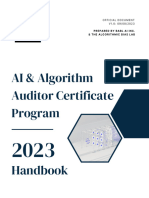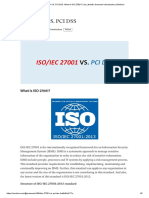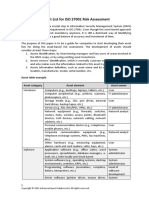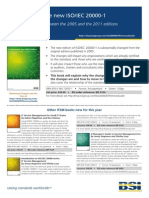0 ratings0% found this document useful (0 votes)
92 viewsPresentation 1
Presentation 1
Uploaded by
Iker EzkerraThe document discusses the structure and key aspects of ISO 42001, which specifies requirements for managing AI systems. It covers the foreword, scope, terminology, requirements, documentation, and risk management considerations of the standard.
Copyright:
© All Rights Reserved
Available Formats
Download as PPTX, PDF, TXT or read online from Scribd
Presentation 1
Presentation 1
Uploaded by
Iker Ezkerra0 ratings0% found this document useful (0 votes)
92 views22 pagesThe document discusses the structure and key aspects of ISO 42001, which specifies requirements for managing AI systems. It covers the foreword, scope, terminology, requirements, documentation, and risk management considerations of the standard.
Original Title
presentation1 (2)
Copyright
© © All Rights Reserved
Available Formats
PPTX, PDF, TXT or read online from Scribd
Share this document
Did you find this document useful?
Is this content inappropriate?
The document discusses the structure and key aspects of ISO 42001, which specifies requirements for managing AI systems. It covers the foreword, scope, terminology, requirements, documentation, and risk management considerations of the standard.
Copyright:
© All Rights Reserved
Available Formats
Download as PPTX, PDF, TXT or read online from Scribd
Download as pptx, pdf, or txt
0 ratings0% found this document useful (0 votes)
92 views22 pagesPresentation 1
Presentation 1
Uploaded by
Iker EzkerraThe document discusses the structure and key aspects of ISO 42001, which specifies requirements for managing AI systems. It covers the foreword, scope, terminology, requirements, documentation, and risk management considerations of the standard.
Copyright:
© All Rights Reserved
Available Formats
Download as PPTX, PDF, TXT or read online from Scribd
Download as pptx, pdf, or txt
You are on page 1of 22
The Anatomy of ISO 42001
SCSD Lecture 1 Feb 2024
The Foreword
• No responsibility, liability, etc
• Users take the risk
• Who is a ”professional”?
• What is “correct application”?
How should it help us?
It should help with processes
What does this mean?
• The first point relates to requirements on the process: why are you
using AI at all? What is the aim of the organization? Who are the
stakeholders?
• Risk management is an essential aspect of any process management
system (and there is a generic approach to it that gets specialized).
• The next point is a list of “concerns” around others – can you think of
others?
• The final point raises the issue of the ”AI supply chain” what does it
look like and who is involved in creating and deploying models.
The scope tells you what the standard is for
What is the scope telling you
• What: the standard sets out to do: “This documents specifies the
requirements….”
• Who: the standard sets out who should be interested in using the
standard: “intended for use by an organization providing or using
products or services that utilize AI systems.”
Other standards, and terminology
Terminology
Main body of the standard
Requirements
Explanatory notes
Referring to Standards
• BS EN ISO/IEC 22989:2023
• Information technology — Artificial intelligence — Artificial
intelligence concepts and terminology
Testable?
Documentation
Organizational perspective
Organisational Policy
Planning
Risk
Summary
• Although we have looked at ISO 42001 this lecture has started to look
at the general structure of management/quality standards.
• Standards generally avoid legally binding commitments
• Standards often sit inside closely related standards
• Standards attempt to have focused scope and refer to other standards.
• Standards requirements should be testable
• Standards often mandate documentation of policies, assessments,
plans, …
• Risk is a key concept in planning
You might also like
- List of Documents Required For ISO 42001 DocumentationDocument8 pagesList of Documents Required For ISO 42001 DocumentationGeneric Ahmedabad100% (1)
- Iso Iec 38500 2024Document10 pagesIso Iec 38500 2024john wattNo ratings yet
- Iso Iec 27014 2020Document11 pagesIso Iec 27014 2020sayed.shoaib hussaini0% (2)
- ISO 27001 2022 Lead Auditor Course Content v1Document16 pagesISO 27001 2022 Lead Auditor Course Content v1anandhardik82No ratings yet
- Iso 27004 - 2016Document11 pagesIso 27004 - 2016RNo ratings yet
- Nis2 DirectiveDocument8 pagesNis2 DirectiveJuan FrancoNo ratings yet
- ISO 27017 2015 Statement of Applicability (SoA)Document4 pagesISO 27017 2015 Statement of Applicability (SoA)Nikos Anastopoulos100% (1)
- Statement of Applicability For ISMS - IsO 27001Document5 pagesStatement of Applicability For ISMS - IsO 27001pvendaraNo ratings yet
- ISO 27032 Cyber Security Managementsoxrp PDFDocument2 pagesISO 27032 Cyber Security Managementsoxrp PDFparentstate80% (1)
- Examples StandardsDocument4 pagesExamples Standardsmulti media50% (2)
- ISMS Statement of ApplicabilityDocument20 pagesISMS Statement of ApplicabilityNatália Gomes Knob100% (1)
- ISO27k ISMS 6.1 SoA 2022Document5 pagesISO27k ISMS 6.1 SoA 2022Natália Gomes KnobNo ratings yet
- Faq Iso Iec 27001 2022Document2 pagesFaq Iso Iec 27001 2022Sudhanshu Kumar Sinha100% (2)
- ISO 27001 MappingDocument17 pagesISO 27001 MappingNikolas Kyriakidis100% (1)
- How ISO 27001 Can Help Achieve GDPR ComplianceDocument7 pagesHow ISO 27001 Can Help Achieve GDPR ComplianceRodica DimitriuNo ratings yet
- ITSC Seminar - 27001 27002 Update Philip SyDocument30 pagesITSC Seminar - 27001 27002 Update Philip SySyed ZiaNo ratings yet
- Introduction To AI Unit 1Document10 pagesIntroduction To AI Unit 1Abdun Nafay QureshiNo ratings yet
- ISO IEC 27001 Lead Implementer A Complete Guide - 2020 EditionFrom EverandISO IEC 27001 Lead Implementer A Complete Guide - 2020 EditionNo ratings yet
- SGS KN AI Clearing FDIS ISOIEC 42001 Case Study FD ENDocument5 pagesSGS KN AI Clearing FDIS ISOIEC 42001 Case Study FD ENJosue FamaNo ratings yet
- Ai Act - The Boundaries of The Risks To GuardDocument36 pagesAi Act - The Boundaries of The Risks To Guarddoamaral.anarosaNo ratings yet
- ISO 271001 - 2022 Audit Checklist Part 1, Part 2, and Part 3Document24 pagesISO 271001 - 2022 Audit Checklist Part 1, Part 2, and Part 3arun.ciscosg100% (1)
- SGS KN ISOIEC 42001 Artificial Intelligence AI Management System Product Sheet ENDocument1 pageSGS KN ISOIEC 42001 Artificial Intelligence AI Management System Product Sheet ENJosue FamaNo ratings yet
- Iso Iec TS 27100-2020Document24 pagesIso Iec TS 27100-2020Calidad2 Spartan PeruNo ratings yet
- Information Security Management SystemDocument24 pagesInformation Security Management Systemafeesh100% (1)
- 01 01 Overview ISO IEC AI For ISO IEC AI Workshop 0623Document112 pages01 01 Overview ISO IEC AI For ISO IEC AI Workshop 0623john_georgakis99100% (3)
- ISO 27001 - 2022 Scoping GuideDocument5 pagesISO 27001 - 2022 Scoping GuideCarlos Martin SantosNo ratings yet
- NIS2 (Art21) Security Measures To NIS1, ISO27001 and ISO27002, and NIST CSF v1.Document4 pagesNIS2 (Art21) Security Measures To NIS1, ISO27001 and ISO27002, and NIST CSF v1.patilpatkarsNo ratings yet
- (2024) Understanding 42001 - Standards AustraliaDocument20 pages(2024) Understanding 42001 - Standards Australiashashis78100% (1)
- Iso 2007Document3 pagesIso 2007Tejendra GohilNo ratings yet
- Australia S New National AI Framework 1719393892Document34 pagesAustralia S New National AI Framework 1719393892HarshNo ratings yet
- Iso 42001 Brochure 2024Document8 pagesIso 42001 Brochure 2024ykshmaxNo ratings yet
- Iso 27001 ChecklistDocument8 pagesIso 27001 ChecklistALEX COSTA CRUZNo ratings yet
- European Union AI Act in Practice: What Does It Mean For Your AI Applications?Document14 pagesEuropean Union AI Act in Practice: What Does It Mean For Your AI Applications?magda.domagalaNo ratings yet
- ISO - IEC - 19941 - 2017 Cloud Interoperability and PortabilityDocument72 pagesISO - IEC - 19941 - 2017 Cloud Interoperability and PortabilityVladimir LicaNo ratings yet
- List of Documents ISO 27001 2022 Documentation Toolkit enDocument5 pagesList of Documents ISO 27001 2022 Documentation Toolkit enLevan Zaalishvili100% (1)
- ISO 27001-2022 Audit Checklist - Part 3Document10 pagesISO 27001-2022 Audit Checklist - Part 3nasser abdelrahmanNo ratings yet
- ISO 27701 Implementation GuideDocument33 pagesISO 27701 Implementation GuideajsihsanNo ratings yet
- ISO27k Standards ListingDocument6 pagesISO27k Standards ListingTikCGNo ratings yet
- Internal Auditing Isms (ISO/IEC 27001:2022)Document17 pagesInternal Auditing Isms (ISO/IEC 27001:2022)The CapitalLand100% (1)
- ISO 27701 PIMS With GDPR Documentation KitDocument15 pagesISO 27701 PIMS With GDPR Documentation Kitwcharles210No ratings yet
- NIST AI RMF To ISO IEC 42001 CrosswalkDocument16 pagesNIST AI RMF To ISO IEC 42001 CrosswalkGavin SkittNo ratings yet
- ISMS Implementation TimelineDocument3 pagesISMS Implementation TimelineJavita CertificationsNo ratings yet
- I17AMER 27001 2022 Auditor Transition PG V1 Nov 2022Document167 pagesI17AMER 27001 2022 Auditor Transition PG V1 Nov 2022qualitychamp6824No ratings yet
- Iso 27701Document14 pagesIso 27701khushisingh1085100% (1)
- Inar Ai Anagement System Iso Iec42001 r2Document59 pagesInar Ai Anagement System Iso Iec42001 r2jjyotiNo ratings yet
- Uk Is3 Participant Guide Issue 2 2022Document291 pagesUk Is3 Participant Guide Issue 2 2022zarraralikhanNo ratings yet
- mITSM - ISO27k Foundation Script v.7.0.ENDocument131 pagesmITSM - ISO27k Foundation Script v.7.0.ENMonica CairesNo ratings yet
- Checklist ISO 27001Document6 pagesChecklist ISO 27001Sheik MohaideenNo ratings yet
- ISO 20000 ChecklistDocument29 pagesISO 20000 ChecklistAlberto HuamaniNo ratings yet
- AI Algorithm Auditor Certificate Handbook 1720372190Document31 pagesAI Algorithm Auditor Certificate Handbook 1720372190hi2mabalajiNo ratings yet
- ISO 27001 VS. PCI DSS. What Is ISO 27001 - by Lakshika Sammani Chandradeva - MediumDocument5 pagesISO 27001 VS. PCI DSS. What Is ISO 27001 - by Lakshika Sammani Chandradeva - MediumJoel Colquepisco EspinozaNo ratings yet
- Soc2 EbookDocument22 pagesSoc2 EbookAmrit BajracharyaNo ratings yet
- TUV Rheinland Academy Portfolio of ServicesDocument65 pagesTUV Rheinland Academy Portfolio of ServicesHR EMBNo ratings yet
- ISO 27701 Annex A Controls Analysis - © NQA 2023Document1 pageISO 27701 Annex A Controls Analysis - © NQA 2023Bruce ROBERTSONNo ratings yet
- Asset List For 27001 Risk Assessment ENDocument3 pagesAsset List For 27001 Risk Assessment ENalbertopazminoNo ratings yet
- Iso 27002 Compliance GuideDocument23 pagesIso 27002 Compliance Guidepioneers ksa100% (1)
- ISO 27001 - 27002 Audit Check List A5 Operational 2Document10 pagesISO 27001 - 27002 Audit Check List A5 Operational 2nasser abdelrahmanNo ratings yet
- A Guide To The New ISO/IEC 20000-1Document2 pagesA Guide To The New ISO/IEC 20000-1Said SakrNo ratings yet
